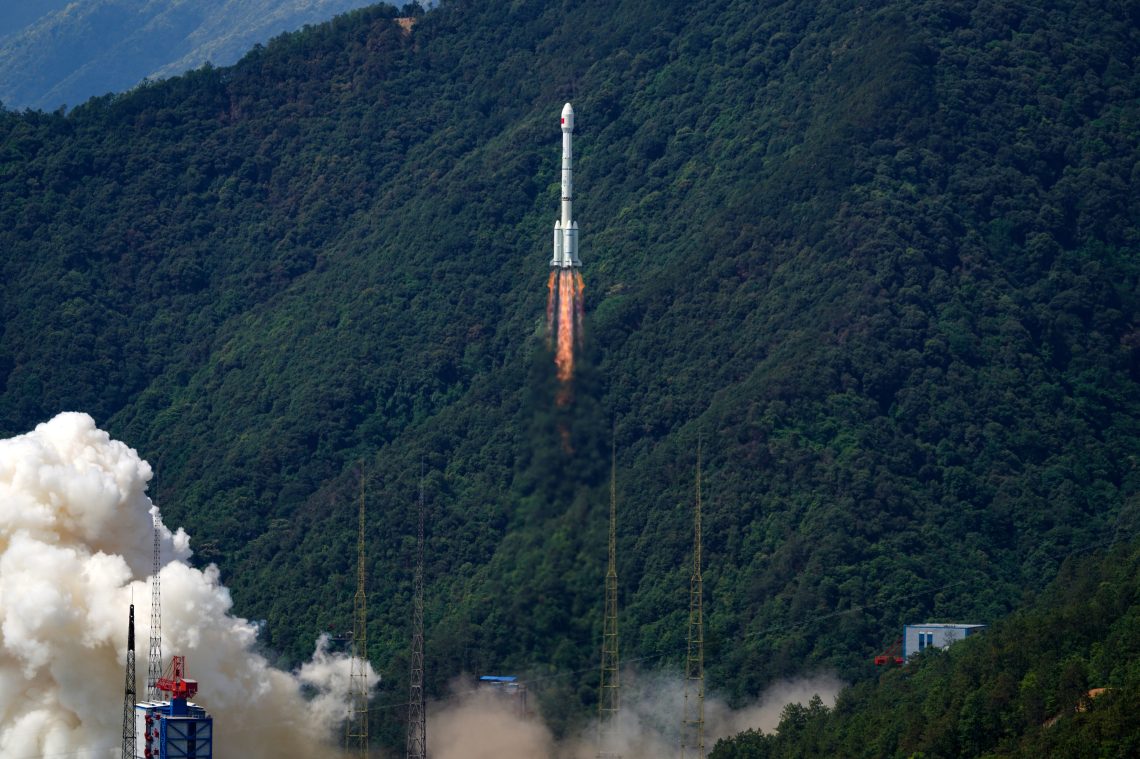Eyeing Taiwan, China builds its own Starlink
Beijing’s ambitions on Taiwan have driven the development of a satellite-based internet network, in the mold of Elon Musk’s Starlink system.

In a nutshell
- Beijing aims to exploit satellite systems against Taiwan
- Starlink-type systems can be disrupted or destroyed
- China can mobilize all private and public players in the effort
Attending the Shangri-La Dialogue in Singapore in early June, Chinese Defense Minister Li Shangfu made clear his stance on the issue of Taiwan: China would never allow Taiwan’s ruling Democratic Progressive Party (DPP) to “seek independence by holding foreign countries hostage”; would never permit external forces to “use Taiwan to control China”; and would never pledge to renounce the use of force.
Given the continued public support for the DPP’s presidential candidate, Lai Ching-te, Taiwan’s more Beijing-antagonistic party will very likely remain in power. If Chinese President Xi Jinping reacts impulsively, a war in the Taiwan Strait could be a distinct possibility – and indeed, China’s People’s Liberation Army (PLA) is preparing for conflict in earnest. This report aims to explore how the Chinese Communist Party is readying for war by examining Beijing’s response to the American Starlink system.
Launched in 2019, Starlink is a satellite-based internet service operated by SpaceX, the American aerospace company run and founded by Elon Musk. As of February 2023, more than 3,500 satellites are in orbit – at the cost of $30 billion, not including maintenance or replacement – and SpaceX plans to bring the total number in the chain to 40,000. When the system numbers 12,000, broadband satellite communications services with higher rates and lower latency will be available. In theory, Starlink can one day meet the communication needs of any corner of the earth, providing high-speed and stable network services. Technologically, low earth orbit (LEO) constellations have demonstrated reliability, dynamism and resilience. The systems are relatively low-cost, yet also state-of-the-art.
Military significance
Starlink’s true value is arguably more military than commercial, despite not being originally designed for use in conflict. As an integral part of the U.S. military’s strategic transformation in space, the Starlink program has promising potential in various areas, including intelligence reconnaissance, interplanetary communications, satellite navigation, precision guidance and missile warning. This poses a new challenge to the traditional model of communication blocking and jamming operations.
Starlink’s pivotal role in the Ukraine war is well-documented. Mere hours before Russia launched a full-scale invasion of Ukraine on February 24, a Russian cyberattack successfully disabled thousands of Ukrainian military routers supplied by the U.S. company Viasat. In the days following the outbreak of the war, Ukrainian Minister of Digital Transformation Mykhailo Fedorov requested Starlink services via a Twitter correspondence with Elon Musk, seeking to ensure stable communications between civilians and the government during the war. In response, SpaceX activated the service within a few hours and had a new terminal shipped to Ukraine in just two days to bolster regional connectivity.
The critical role of Starlink in the war in Ukraine is undeniable, but it has not come without associated risks.
Since its launch, the Starlink service has been utilized by both civilians and military officials. Kyiv’s military has employed the technology in innovative ways on the battlefield, using it to control unmanned surveillance and reconnaissance aerial vehicles and drones. The tactic has played a crucial role in striking deep Russian targets from a considerable distance. The success of Ukraine’s HIMARS rocket system also depends on the U.S. sharing target information and intelligence via Starlink.
Of course, Starlink has been subject to frequent Russian interference and attacks. Yet the system has demonstrated a strong ability to respond quickly to new threats, eliminating interference swiftly after a cyber electronic attack.
Starlink’s potential in Taiwan
As early as September of last year, researchers at the PLA’s Army Engineering University posited in an article that “the excellent performance of Starlink satellites in this Russian-Ukrainian conflict will certainly prompt the U.S. and Western countries to use Starlink extensively” in any Asian theater of conflict. This, of course, is a reference to Taiwan. It is no coincidence that U.S. House Foreign Affairs Committee Chairman Michael McCaul, in a meeting with Taiwanese President Tsai Ing-wen this year, broached the possibility of introducing the Starlink internet satellite constellation to Taiwan, with the goal of countering mainland China’s military deterrence.
The current backlog of delayed U.S. arms sales to Taiwan has reached $18.7 billion, including 208 Javelin anti-tank missiles and 215 Stinger antiaircraft missiles. Beijing needs the ability to intercept Starlink satellites in low-earth orbit and to protect tanks and helicopters from shoulder-fired Javelin missiles. In China today, hundreds of specialists are trying to learn lessons from the war in Ukraine for potential future attacks against Taiwan.

Three ways to counter Starlink
The critical role of Starlink in the war in Ukraine is undeniable, but it has not come without associated risks. Broadly, there are several methods to locate, jam, degrade or even destroy these devices, which were never originally designed for battlefield use.
The first method involves conventional jamming. The Russian military has repeatedly initiated cyberattacks attempting to disrupt Starlink’s operational code. The interruptions to Starlink communications, particularly those last September-October, are thought to be the product of Russian cyber warfare. In general, however, SpaceX has been able to effectively rectify the code to isolate Russian cyberattacks, making a permanent disruption of Starlink’s functionality challenging.
It is widely believed that Russia has used more advanced jamming equipment in recent months, such as the Tobol system, as well as other jammers like the truck-mounted Tirada-2 system. According to a report released this month by the Secure World Foundation, NATO analysts have identified at least seven Tobol complexes in Russia, all located next to facilities used for satellite tracking. Russia’s effective military performance in Bakhmut is directly tied to its success in hindering the Starlink system. (Of course, Russian satellite jamming can itself be circumvented, by adjusting the software of Starlink.)
The second method is to directly attack the satellites. However, given that the Starlink system currently boasts more than 3,500 satellites in orbit and that these satellites are relatively inexpensive to manufacture and launch – far cheaper than the cost of an anti-satellite weapon – interceptor missiles against these large, high-value targets prove ineffective. Not only is it economically impractical to use such weapons against Starlink satellites, but the construction of thousands of anti-satellite missiles to execute the attack is also a logistical challenge.
The third method involves “fighting fire with fire,” which is to say, seizing orbital resources and launching countless satellites of their own to suppress the network – a strategy that is primarily favored by the Chinese military.
Satellite space race
According to the International Telecommunication Union (ITU), the United Nations’ satellite deployment registry, the right to utilize satellite frequencies and orbital resources is determined on a “first-come, first-served” basis, thereby creating a competitive environment. As a result, Chinese researchers deem it essential to establish their own star chain system and partake in a low-orbit race to secure orbital and frequency resources.
In alignment with this concept, on April 28, 2021, the Chinese government issued a document announcing the formation of the China Satellite Network Group Co., colloquially referred to as “GW,” the pinyin abbreviation for “State Grid.” In 2020, China submitted a plan to the International Satellite Union comprising an expansive constellation of 12,992 low-orbit internet satellites. The aim was “to prevent excessive seizure of low-orbit resources” by the network of Starlink satellites. If it grew large enough, it could be utilized to monitor rival networks and perform counter-satellite chain operations, and even suppress the American Starlink.
Read more about space technologies
Space invaders: The rise of commercial firms
In fact, the ITU has also received applications from China to build two satellite constellations. Currently, the state-owned enterprise Space Science and Technology Group’s Hongyan Project is actively launching low-orbit satellites, and the Aerospace Science and Industry Group has initiated another program called the Hong Yun Project. Even private sector individuals, such as Lei Jun, the founder of Xiaomi, and Li Shufu of Geely, have begun their own low-orbit satellite programs. It is anticipated that at some point, the Chinese government will likely integrate these endeavors under the banner of national security.
Scenarios
However, realizing such a plan is no small feat. It requires substantial financial resources, and given China’s current economic stagnation, even the military has doubts about its ability to complete such an ambitious program on schedule. While China will undoubtedly achieve a certain version of its own Starlink-type project, it will likely struggle to rival the original, let alone compete with the more advanced New Starshield Project that Elon Musk’s SpaceX is currently developing in partnership with the U.S. military.
Nonetheless, deviating from past practices, China is mobilizing all players, both private and state-owned companies, to join the campaign. As an authoritarian regime, China can easily compel private enterprises to comply with national interests. There will likely be no disruptions due to individual decisions, like when Elon Musk threatened to shut down Starlink entirely due to its military use by the Ukrainians due to the costs involved.
A recent leak of U.S. intelligence indicates that mainland China is developing advanced cyber weapons to “seize control of enemy satellites” and render them ineffective for data signals or surveillance during wartime. China has now developed a compact power source that could significantly reduce the size of high-powered microwave weapons used to target Starlink satellites. This device can generate up to 10 gigawatts of power, producing high-intensity energy capable of emitting enough microwaves to damage drones, aircraft and even satellites. Microwave weapons, which rely solely on electrical power to disrupt satellite communications or inflict irreversible damage to their electronic systems, are notably effective against targets like Starlink. Over the last few months, the Chinese military has expedited the development of high-powered microwave weapons. Besides microwave weapons, China’s military industry is also increasingly utilizing lasers as an efficient and cost-effective countermeasure against Starlink.
There will likely be a series of future developments related to China’s response to U.S. Starlink. If plans to forcefully seize Taiwan remain in play, China will persist in developing as many options as possible to meet the challenges posed by the satellite network.








